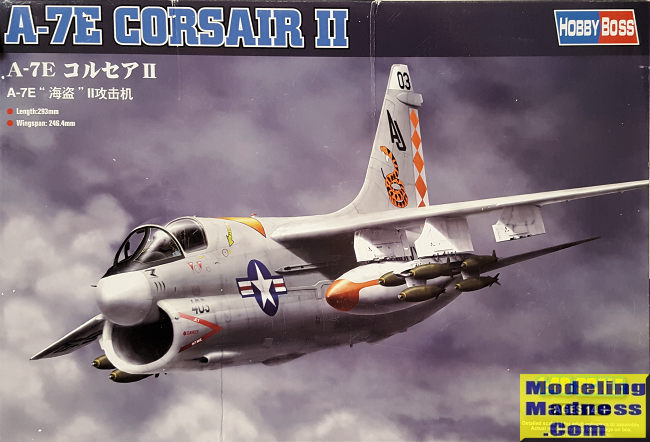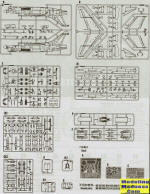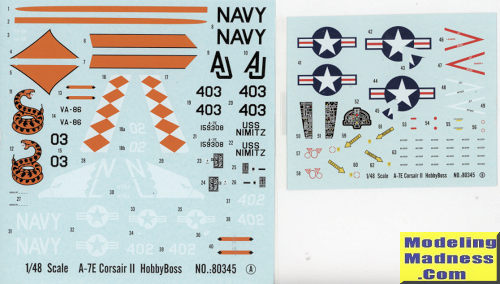
| KIT #: | 80345 |
| PRICE: | ~$42.00 delivered from China |
| DECALS: | Two options |
| REVIEWER: | Scott Van Aken |
| NOTES: | 2018 release |

| HISTORY |
The Navy was sufficiently impressed with the increased power offered by the A-7D Spey engine used by the Air Force, and decided to use this engine for its own version of the Corsair II. The designation A-7E was assigned, and this version was to succeed the A-7B in production. However, there were delays in the deliveries of the TF41-A-2 engine specified for the A-7E, so the first 67 aircraft of the order were delivered with the TF30-P-8 engine. These aircraft had all of the other improvements planned for the A-7E, including the improved avionics and the M61 rotary cannon, and were re-designated A-7C after delivery.
The first Spey-powered A-7E flew for the first time on 9 March 1969. The A-7E differed from the USAF A-7D in retaining the probe-and-drogue midair refueling system of the earlier A-7A/B. It entered service in Southeast Asia in May 1970 with VA-146 and VA-147 deployed aboard USS America. The A-7E participated in numerous close-air support missions over both North and South Vietnam, with its state-of-the-art bombing and navigation system being particularly reliable and accurate. Most air wings operating A-4 Skyhawks and early A-7s were re-equipped with A-7Es. The A-7E participated in the mining of Haiphong harbor in 1972, and played a vital role in Operations Linebacker I and Linebacker II that led up to the formal end of US involvement in the Vietnam War on 24 January 1973.
On 15 May 1975, A-7E aircraft operating from USS Coral Sea, in conjunction with A-7D aircraft assigned to the 3d TFS at Korat RTAFB, provided air cover in what is considered the last battle of the Vietnam War, the recovery of SS MayagŁez after it was hijacked by Khmer Rouge gunboats.
| THE KIT |
 Hobby
Boss has produced a full series of A-7s in both 1/72 and 1/48. Like most Hobby
Boss kits, the detailing is very good and they provide a lot for your money.
Also like some Hobby Boss kits, there are some major shape issues. It seems they
used both the Hasegawa and the Monogram A-7 kits as a basis for this one. By
that I mean you get features found on the Hasegawa kit, like the open avionics
bay doors and features found on the Monogram kit like the too wide intake and
canopy/windscreen. Why things like this happen is quite beyond me as there is no
lack of reference photos and even museum aircraft that can be used for reference
to get the shape right. Fortunately for the modeler, there is a replacement
upgrade for the intake and the nose from Cat 4 in Ukraine though it means
cutting away the lower forward fuselage to install the set. There is no fix for
the upper fuselage yet. What makes it so irritating is that the box art has all
the dimensions correct.
Hobby
Boss has produced a full series of A-7s in both 1/72 and 1/48. Like most Hobby
Boss kits, the detailing is very good and they provide a lot for your money.
Also like some Hobby Boss kits, there are some major shape issues. It seems they
used both the Hasegawa and the Monogram A-7 kits as a basis for this one. By
that I mean you get features found on the Hasegawa kit, like the open avionics
bay doors and features found on the Monogram kit like the too wide intake and
canopy/windscreen. Why things like this happen is quite beyond me as there is no
lack of reference photos and even museum aircraft that can be used for reference
to get the shape right. Fortunately for the modeler, there is a replacement
upgrade for the intake and the nose from Cat 4 in Ukraine though it means
cutting away the lower forward fuselage to install the set. There is no fix for
the upper fuselage yet. What makes it so irritating is that the box art has all
the dimensions correct.  Mavericks,
and GBU-10s. Pretty sure Navy A-7s did not carry the Mavericks, though not sure
about the LGBs. A pair of Sidewinders are also included and the Corsair did
carry those or at least the pylons for them.
Mavericks,
and GBU-10s. Pretty sure Navy A-7s did not carry the Mavericks, though not sure
about the LGBs. A pair of Sidewinders are also included and the Corsair did
carry those or at least the pylons for them. | CONCLUSIONS |
| REFERENCES |
https://en.wikipedia.org/wiki/LTV_A-7_Corsair_II#Improved_A-7E
January 2023
Copyright ModelingMadness.com. All rights reserved. No reproduction in part or in whole without express permission from the editor.
If you would like your product reviewed fairly and fairly quickly, please contact the editor or see other details in the Note to Contributors.